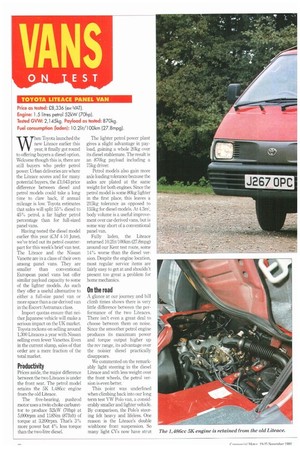Price as tested: £8,336 (ex-VAT).
Page 22

Page 23

If you've noticed an error in this article please click here to report it so we can fix it.
Engine: 1.5 litres petrol 52kW (70hp).
Tested GVW: 2,145k9. Payload as tested: 870k9. Fuel consumption (laden): 10.2lit/100krn (27.8mpg).
When Toyota launched the new Liteace earlier this year, it finally got round to offering buyers a diesel option. Welcome though this is, there are still buyers who prefer petrol power. Urban deliveries are where the Liteace scores and for many potential buyers, the £1,043 price difference between diesel and petrol models could take a long time to claw back, if annual mileage is low. Toyota estimates that sales will split 55% diesel to 45% petrol, a far higher petrol percentage than for hill-sized panel vans.
Having tested the diesel model earlier this year (CM 4-10 June), we've tried out its petrol counterpart for this week's brief van test. The Liteace and the Nissan Vanette are in a class of their own among panel vans, They are smaller than conventional European panel vans but offer similar payload capacity to some of the lighter models. As such they offer a useful alternative to either a full-size panel van or more space than a car-derived van in the EscortiAstramax class Import quotas ensure that neither Japanese vehicle will make a serious impact on the UK market. Toyota reckons on selling around 1,300 Liteaces a year with Nissan selling even fewer Vanettes. Even in the current slump, sales of that order are a mere fraction of the total market.
Productivity
Prices aside, the major difference between the two Liteaces is under the front seat. The petrol model retains the 5K 1,48.6cc engine from the old Liteace.
The five-hearing, pushrod motor uses a twin-choke carburettor to produce 52kW (70hp) at 5,000rpm and 118Nm (871bft) of torque at 3,200rpm. That's 3% more power but 4% less torque than the two-litre diesel. The lighter petrol power plant gives a slight advantage in payload, gaining a whole 20kg over its diesel stablemate. The result is an 870kg payload including a 75kg driver.
Petrol models also gain more axle loading tolerance because the axles are plated at the same weight for both engines. Since the petrol model is some 80kg lighter in the first place, this leaves a 215kg tolerance as opposed to 155kg for diesel models. At 4.3m, body volume is a useful improvement over car-derived vans, but is some way short of a conventional panel van.
Fully laden, the Liteace returned 10.21it/100km (27.8mpg) around our Kent test route, some 14% worse than the diesel version. Despite the engine location, most regular service items are fairly easy to get at and shouldn't present too great a problem for home mechanics.
On the road A glance at our journey and hill climb times shows there is very little difference between the performance of the two Liteaces. There isn't even a great deal to choose between them on noise. Since the smoother petrol engine produces its maximum power and torque output higher up the rev range, its advantage over the noisier diesel practically disappears.
We commented on the remarkably light steering in the diesel Liteace and with less weight over the front wheels, the petrol version is even better.
This point was underlined when climbing back into our long term test VW Polo van, a considerably smaller and lighter vehicle. By comparison, the Polo's steering felt heavy and lifeless. One reason is the Liteace's double wishbone front suspension. So many light CVs now have strut type front suspension that we tend to forget how that layout can load up steering weight.
Other controls arc equally pleasant to use, like the light clutch, incisive gear change and progressive brakes. The cab is also a reasonable environment to work in. Excellent door mirrors aid the good visibility, while the light grey mouldings are easy on the eye and shouldn't be difficult to keep clean.
As we commented before, however, space is at a premium in the cab. There isn't much elbow room or stowage space and despite the improved safety features, the forward-control layout still generates a feeling of vulnerability There might be side-impact protection bars in the doors and reinforced front chassis members, but there is precious little distance between the driver and the outside world.
Similarly, despite the claimed 9% improvement in crosswind stability, the Liteace can be blown off course all too easily Without a load to pin the back end down, handling can also be skittish. Summary The Liteace is at its best in town, where its compact dimensions and manoeuvrability give it the edge over conventional panel vans. Urban roads are less likely to show up its deficiencies in a crosswind too.
Unfortunately, at 18,336 (exVAT), the Liteace is far from cheap compared with its more obvious rivals. This is probably because it's a newer design than most of them and has safety features that many other forwardcontrol models lack. The most obvious rival, Nissan's petrolenginecl Vanette, is over £1,000 cheaper at £7,100 (ex-VAT). Other petrol powered competitors, such as the Renault Trafic Prima, Leyland Daf 200 City 2.2-tonner, Mitsubishi short-wheelbase 1,300 and Vauxhall Midi Merit, are all cheaper, Since small businesses, the Liteace's obvious market, have been so badly affected by the recession, a premium price can't be good news for Thyota dealers at the moment.
by John Kendall
















































































